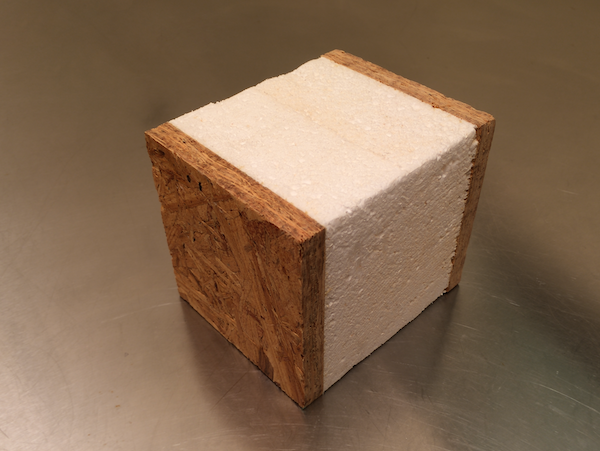Structural insulated panels (SIPs) are a high-performance building system for residential and light commercial construction. They used to construct walls, ceilings, and floors for residential and light commercial properties. They are a type of composite sandwich panel system that forms an insulating core.The panels consist of an insulating foam core sandwiched between two structural facings, typically oriented strand board (OSB). SIPs are manufactured under factory controlled conditions and can be fabricated to fit nearly any building design. The result is a building system that is extremely strong, energy-efficient and cost-effective. SIPs not only have high R-values but also high strength-to-weight ratios. An SIP typically consists of 4- to 8-inch thick foam board insulation sandwiched between two oriented strand boards (OSB) or other structural facing materials.
Manufacturers usually can customize the exterior and interior sheathing materials according to customer requirements. The facing is glued to the foam core. The panel is then either pressed or placed in a vacuum to bond the sheathing and core together. Structural insulated panels are composed of an insulated foam core between two rigid board sheathing materials. The foam core is generally one of the following: expanded polystyrene (EPS), extruded polystyrene (XPS), and polyurethane foam (PUR). With EPS and XPS foam, the assembly is pressure laminated together. With PUR and PIR, the liquid foam is injected and cured under high pressure. The most common sheathing boards are oriented strand boards (OSB). Other sheathing materials include: sheet metal, plywood, fiber-cement siding, magnesium-oxide board, fiberglass mat gypsum sheathing, and composite structural siding panels.
Advantages of structural insulated panels
A well-built home using SIPs will have a tighter building envelope and the walls will have higher insulating properties, which leads to fewer drafts and a decrease in operating costs. Also, due to the standardized and all-in-one nature of SIPs, construction time can be less than for a frame home, as well as requiring fewer tradespeople. The panels can be used as floor, wall, and roof, with the use of the panels as floors being of particular benefit when used above an uninsulated space below. Its advantages includes;
- Can be used in internal and external walls, floors, and roof surfaces
- Eliminates the need for roof trusses
- Stronger and less susceptible to shifting
- Energy efficient than those constructed with traditional framing.
- Equivalent U-values can be achieved with thinner walls
- Good load bearing
- Resistant to mold
- Lateral strength
- Highest R-value/inch; strength
- Water resistant
Types of structural insulated panels
Expanded polystyrene insulated panels
Expanded Polystyrene (EPS) panels act as insulation panel in composite sandwich panels with Expanded Polystyrene (EPS) insulation as core. EPS panels have multiple applications in the construction industries. They can be used in cavity wall, duct and floor insulation, void filling, floor raising and packaging application. High density panels are recommended for insulation and floor raising applications. Low density panels which has good resilience property can be used for packaging applications.EPS panels are manufactured using polystyrene beads that are expanded to their size through a chemical process that uses heat. Once they’ve melded, they’re compressed between PPGI sheets into varying sizes of EPS blocks through different moulds. These are further cut and shaped for different industry requirements. They are also customizable and can be manufactured in different densities as per client requirements. EPS panels are a viable option owing to their sheer strength and durability and are best suited for walls as well as roofing.

Polyurethane insulated panels
Polyurethane Insulation Panels are versatile and can be used for interior or exterior walls, partitions, roofing, ceiling in commercial, industrial or residential buildings, warehouses, cold rooms and clean rooms, factory buildings, prefab containers and cabins. Polyurethane Panels are especially highly efficient in industries like food processing, refrigeration, pharmaceuticals and drug storage, fish and dairy, etc. insulated partitions enable you to divide your interior space into cool and normal temperature zones.

Compressed straw insulated panels
These are manufactured using renewable and recycled waste agricultural straw, unlike other panel materials. They are environmentally friendly and provide excellent thermal insulation, thermal storage and sound insulation as well as a high resistance to mold, pests and fire.

Application of structural insulated panels
- Pitched roofs
- Walls
- Hospitals
- schools
- restaurants
- camp
- warehouses
Conclusion
SIP panels are made by sandwiching a core of rigid foam plastic insulation between two structural facings, such as oriented strand board (OSB). Other skin materials can be used for specific purposes. SIPs are manufactured under factory controlled conditions and can be custom designed for each project. SIP panels deliver unrivaled insulation and airtightness, which reduces energy costs over the building’s lifetime. A SIP building envelope has minimal thermal bridging and delivers excellent airtightness.

